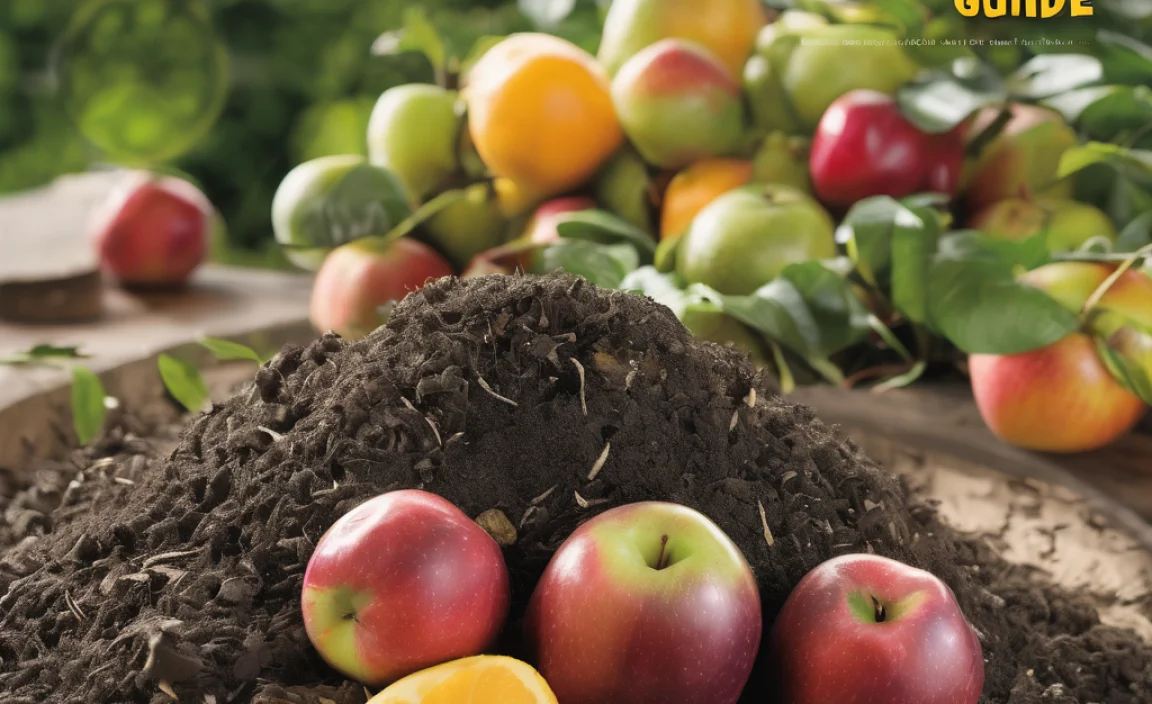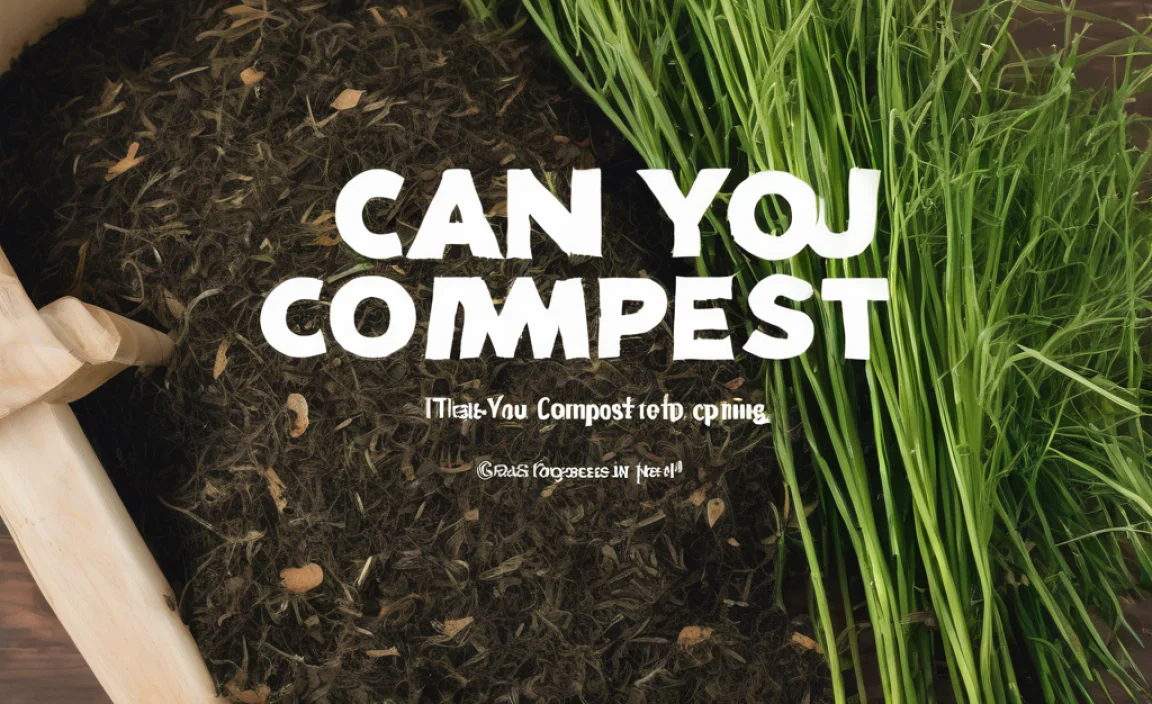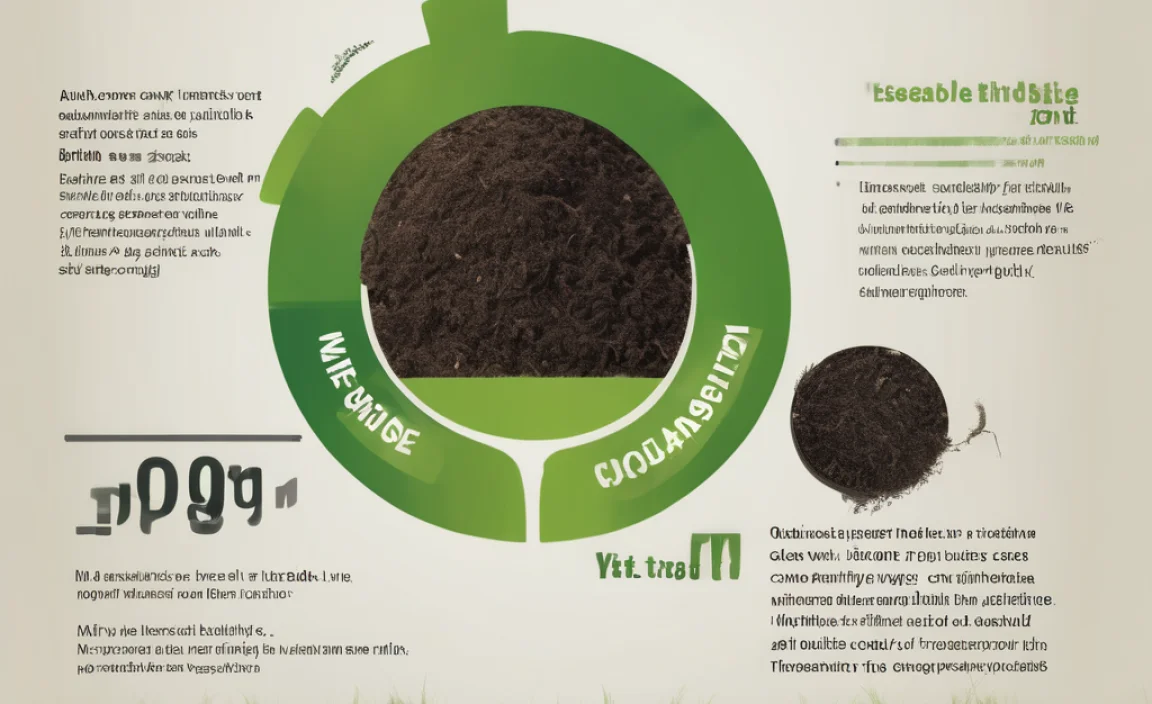Hey there, gardening friends! Ever look at your kitchen scraps and think, “There’s gotta be a better way than the trash can”? You’re in luck! Vermicomposting, or worm composting, is a super simple way to turn those scraps into amazing ‘black gold‘ for your plants. It sounds a bit fancy, but I promise it’s easy to get started. Let’s dive in and see how you can become a worm-wrangling pro right here in the USA!
Vermicomposting in USA: Your Essential Guide to Wiggly Wonders
So, you’re curious about vermicomposting in the USA, huh? That’s fantastic! It’s a fantastic way to reduce waste and create incredibly rich fertilizer for your garden, balcony plants, or even just that herb you’re growing on your windowsill. My name’s Troy D Harn, and at TopChooser, I love breaking down big projects into bite-sized, doable steps. Vermicomposting might sound a little… earthy, but it’s surprisingly straightforward and incredibly rewarding. Think of it as nature’s ultimate recycling program, powered by a team of hungry worms!
This guide is designed specifically for beginners who want to get started with vermicomposting in the US. We’ll cover everything from choosing your worms and bin to feeding them and harvesting your finished compost. No complex jargon, just practical advice to help you succeed. Ready to get your hands a little dirty (in the best way possible)? Let’s get started!
Why Vermicompost? The Benefits of Wormy Goodness
Before we get our hands dirty, let’s talk about why vermicomposting is such a brilliant idea, especially for us home gardeners in the USA.
- Waste Reduction: A huge chunk of what we throw away is organic material – fruit peels, veggie scraps, coffee grounds. Worm composting diverts this from landfills, saving space and reducing methane gas production.
- Super-Powered Fertilizer: Worm castings (that’s worm poop!) are packed with nutrients that plants absolutely love. They improve soil structure, drainage, and aeration, leading to healthier, happier plants. It’s often called ‘black gold’ by gardeners for a reason!
- Faster Than Traditional Composting: Worms work much faster than the microbes involved in traditional hot composting, meaning you can get usable compost in as little as a few months.
- Great for Small Spaces: You don’t need a sprawling backyard! Vermicomposting can be done indoors or outdoors in a relatively small bin, making it perfect for apartment dwellers, condo owners, or anyone with limited space.
- Educational and Fun: It’s a fantastic learning experience, especially for families. Kids (and adults!) are often fascinated by how the worms transform food scraps into valuable soil amendment.
Choosing Your Worms: Not Just Any Earthworm Will Do!
This is a crucial step! You don’t just go out and dig up regular garden earthworms. They aren’t built for the bin and won’t thrive. For vermicomposting, you need specific types of composting worms, often called red wigglers. These little guys are voracious eaters and reproduce well in captivity.
The most popular worms for vermicomposting in the USA are:
- Eisenia fetida (Red Wigglers): These are the superstars of the worm bin. They are hardy, reproduce quickly, and are excellent at processing organic waste.
- Eudrilus eugeniae (African Nightcrawlers): These are larger and can process food waste even faster, but they prefer slightly warmer temperatures than red wigglers.
- Perionyx excavatus (Indian Blue Worms): Another excellent choice, known for their prolific breeding.
You can purchase these worms online from reputable worm farms or sometimes from local gardening stores or communities. A common starting amount is about 1 pound of worms.
Selecting Your Vermicomposting Bin
The good news is you don’t need a fancy, expensive setup to start vermicomposting. Many options work, from DIY bins to store-bought systems.
DIY Bin Options:
If you’re handy, you can easily build your own bin. Here are a couple of popular DIY methods:
- Stacking Totes: This is a favorite for simplicity and affordability. You’ll typically need two or three opaque plastic storage totes (around 10-20 gallons each).
- Bin 1 (Bottom): This bin serves as a leachate collector (the liquid that drains from the compost). No holes needed!
- Bin 2 (Middle – the Bedding Bin): Drill several small holes (about 1/8 inch) in the bottom of this bin. Later, you’ll drill larger holes (about 1/2 inch) around the sides near the top for ventilation. This is where your worms and bedding will live.
- Bin 3 (Optional Top): If you’re using a stacking system with multiple working bins, this one would be identical to Bin 2, also with holes in the bottom. This allows you to stack them and have worms migrate upwards as they eat through the lower bin’s contents.
- Wooden Bins: You can build a simple box out of untreated lumber. Ensure it has good drainage and ventilation. You can line the bottom with mesh to prevent worms from escaping.
Commercial Bin Options:
If DIY isn’t your thing, there are many excellent pre-made worm composting bins available. These are often called “worm farms” or “worm composting systems.”
- Stacking Systems: Similar to the DIY stacking totes, these systems have multiple trays where bedding and food are placed. As the lower trays are processed, worms migrate upwards to new food in the trays above.
- Single-Tray Systems: These are simpler, often just one large bin with a lid. They work well for smaller volumes of food scraps.
Important Considerations for Your Bin:
- Opaque: Worms prefer the dark. Opaque bins protect them from light.
- Ventilation: Airflow is crucial. Most bins need some holes for air to get in and out.
- Drainage: Excess moisture needs a way to escape. This collected liquid, called leachate, can be diluted and used as a nutrient-rich fertilizer for plants.
- Size: A common starting size is 10-20 gallons. This can handle a good amount of kitchen scraps from a typical household.
Setting Up Your Worm Bin: Getting Cozy for Your Worms
Your worms need a cozy place to live, and that means preparing their bedding. This is the material they’ll live in, eat from, and burrow through.
Ideal Bedding Materials:
- Shredded Newspaper: Black and white ink is fine. Avoid glossy paper. Tear or shred it into strips about 1-2 inches wide.
- Shredded Cardboard: Similar to newspaper, plain cardboard is best.
- Coconut Coir: This is a popular choice. You buy it compressed and rehydrate it with water. It’s lightweight and holds moisture well.
- Peat Moss: Works well but can be less sustainable than other options.
- Aged Compost or Soil: A small amount can help introduce beneficial microbes.
How to Prepare the Bedding:
- Moisten the Bedding: The key is to get it damp, like a wrung-out sponge. It should not be dripping wet. If you’re using coco coir, follow package instructions for rehydration. If using newspaper or cardboard, soak it briefly and then squeeze out excess water.
- Fluff it Up: Mix the moistened materials thoroughly. You want it airy for good oxygen flow.
- Fill the Bin: Fill your prepared worm bin (the one with holes in the bottom) about halfway to two-thirds full with the moistened bedding.
- Settle the Bedding: Let the bedding sit for a day or two before introducing the worms. This allows it to cool down if it warmed up during moistening and lets any initial activity settle.
Introducing Your Worms to Their New Home
Once your bin is set up and the bedding is ready, it’s time to add your wormy friends!
- Gently Unpack Worms: Carefully remove your worms from their shipping container.
- “Plant” Them: Make a few small furrows or depressions in the surface of the bedding. Gently place the worms into these openings.
- Cover Them Up: Gently cover the worms with a thin layer of bedding. They will quickly burrow down to escape the light.
- Initial Rest: Leave the worms to settle in for a few days without feeding them. They need time to adjust to their new environment.
What to Feed Your Worms (and What to Avoid!)
Worms are not picky eaters, but there are definitely some foods they love and some they are better off without.
Good Foods (Feed in moderation):
- Fruit scraps (apples, bananas, berries, melons)
- Vegetable scraps (carrots, lettuce, broccoli, potato peels)
- Coffee grounds and paper filters
- Tea bags (remove staples)
- Crushed eggshells (great for grit and calcium)
- Plain cooked pasta or rice (in small amounts)
- Oatmeal or cornmeal (as a treat, in small amounts)
Foods to Avoid (or feed very sparingly):
- Citrus fruits: Too acidic and can harm the worms. Small amounts of orange or lemon peel are okay, but not large quantities.
- Onions, garlic, and spicy peppers: Their strong oils and compounds can be irritating.
- Meat, dairy, and oily foods: These can attract pests, create foul odors, and go rancid.
- Processed foods: Too many chemicals and salt.
- Pet waste: Can contain pathogens.
- Yard waste: Large amounts of grass clippings or leaves can become too matted and anaerobic.
- Diseased plants: Avoid introducing any plants that may carry disease.
Feeding Tips:
- Start Small: When you begin feeding, offer only a small amount. You want to avoid overfeeding, which can lead to anaerobic conditions and smelly issues.
- Chop it Up: The smaller the food pieces, the faster the worms can process them.
- Bury the Food: Bury the food scraps under the bedding. This helps prevent odors and keeps pests away. You can rotate where you bury the food so the worms work through the entire bin.
- Observe: Pay attention to how quickly the food disappears. If food is left behind after a week, you’re feeding too much. If it’s gobbled up quickly, you can increase the amount slightly.
Maintaining Your Worm Bin: Keeping Things Happy and Healthy
A happy worm bin is a productive worm bin! Here’s what you need to keep in mind for ongoing maintenance:
Moisture Levels
As mentioned, the bedding should stay consistently damp, like a wrung-out sponge. If it looks dry, mist it with water. If it’s too wet (and smells), you might need to add more dry bedding or improve ventilation. The bedding and the worms’ environment should be moist but not waterlogged.
Temperature
Red wigglers prefer temperatures between 55°F and 77°F (13°C and 25°C). If your bin is outdoors in a very hot climate, you might need to provide shade or even move it indoors during peak summer. In colder areas, ensure it’s protected from freezing. The ideal temperature range is crucial for worm reproduction and activity.
Aeration
Worms need oxygen! Periodically, you can gently fluff the top layer of the bedding with a garden fork or your hands. Be careful not to disturb the worms too much. The holes in your bin also play a big part in this.
pH Levels
Worms thrive in a neutral pH environment (around 6.0-7.0). Overfeeding acidic foods like citrus can lower the pH. Adding crushed eggshells not only provides grit for the worms but also helps buffer the pH.
Harvesting Your Worm Castings: The Black Gold!
This is the exciting part – collecting the nutrient-rich compost your worms have created! Worm casting harvesting can be done in a few ways, depending on your bin type.
Method 1: The “Migrate Up” Method (for stacking bins)
- Stop Feeding: For about a week to 10 days, stop adding food scraps to the bin you want to harvest from.
- Add Fresh Bedding and Food Above: In the next level of your stacking system, add fresh bedding topped with a new layer of food scraps.
- Wait for Migration: The worms will naturally migrate upwards towards the fresh food and bedding. This can take a few weeks.
- Harvest: Once you see most of the worms have moved to the upper bin, you can remove the lower bin for harvesting. You might have a few stragglers, which you can pick out by hand or return to the working bin.
Method 2: The “Light Scare” Method (for single-bin systems)
- Empty the Bin: Take all the contents of your worm bin and dump them onto a tarp or plastic sheet in a brightly lit area (preferably outdoors).
- Create Piles: Divide the contents into several cone-shaped piles.
- Wait: The worms will burrow down to escape the light and heat. Wait about 10-15 minutes.
- Harvest Top Layers: Carefully scoop off the top layer of compost. You’ll find fewer worms in this layer. Repeat this process, scooping off layer by layer.
- Collect Worms: As you get to the bottom of the piles, you’ll find most of the worms. Collect these and put them back into your prepared worm bin with fresh bedding.
Method 3: The “Screening” Method
This is best for well-established compost. You can use a screen (like a mesh sieve or a custom-built screen box) to sift the compost. The worm castings will fall through, while larger undigested items and cocoons will remain on top to be returned to the bin.
What to do with your castings:
- Directly in Garden Beds: Mix them into your soil before planting.
- Top Dressing: Sprinkle a layer around existing plants.
- Compost Tea: Steep castings in water to create a liquid fertilizer.
- Potting Mix: Add them to your homemade potting soil mixes.
Troubleshooting Common Vermicomposting Issues
Even with the best intentions, you might encounter a few hiccups. Don’t worry – they’re usually easy to fix!
Issue: Foul Odors
Causes: Overfeeding, too much moisture, lack of aeration, feeding forbidden foods (meat, dairy).
Solutions: Stop feeding for a week or two. Add more dry bedding material. Gently fluff the bedding to aerate. Ensure proper drainage. Only feed approved items.
Issue: Fruit Flies or Gnats
Causes: Exposed food scraps on the surface.
Solutions: Bury food scraps completely under the bedding. Avoid overfeeding. Try adding a layer of dry shredded newspaper on top of the food. You can also try setting simple fruit fly traps near the bin (e.g., a jar with apple cider vinegar and a drop of dish soap).
Issue: Too Wet
Causes: Overwatering, bin not draining properly, too much watery food.
Solutions: Add dry bedding material (shredded newspaper, coco coir) to absorb excess moisture. Ensure drainage holes are clear. If using a stacking system, make sure the leachate collector isn’t full and overflowing.
Issue: Too Dry
Causes: Not enough moisture, poor ventilation causing evaporation.
Solutions: Mist the bedding with water. Gently mix the bedding to distribute moisture. Make sure ventilation holes aren’t blocked.
Issue: Worms Trying to Escape
Causes: Unfavorable conditions (too wet, too dry, too acidic, temperature extremes, lack of air).
Solutions: Check and correct the bin’s conditions (moisture, temperature, pH, aeration). Make sure there are no gaps or holes they can get through other than designed ventilation.
Quick Comparison: DIY vs. Commercial Worm Bins
Choosing between building your own or buying a pre-made bin is a common decision. Here’s a quick look to help you decide:

I am passionate about home engineering. I specialize in designing, installing, and maintaining heating, ventilation, and air conditioning systems. My goal is to help people stay comfortable in their homes all year long.



